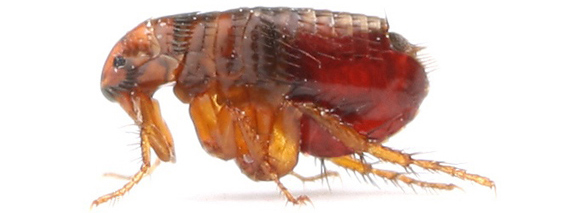Fleas

Origins and distribution
Present worldwide and found throughout the UK.
Characteristics
Fleas are approximately 2 – 3 mm long and a dark mahogany colour, they are laterally flattened to enable them to pass through the hairs of their host such as a cat or dog. They have large hind legs enabling them to jump huge distances relative to its size. The larvae are a white/pale straw colour and resemble more of a caterpillar than the adult, growing up to 5 mm in size.
Breeding
Females can lay anything up to 1000 eggs, which are white in colour and 1 mm in size. These are laid after feeding on a blood meal. These take about 2 days to hatch and the larvae having to go through 2 – 3 moults over a 3 week period. Pupation takes 2 – 4 weeks but can take much longer (several months) depending upon temperature.
Habits
The cat flea is the commoner of the two species which comes into contact with humans and despite the name is commonly found on dogs. They reside on their host but often spend times away in and around the bedding area. The larvae feed around the bedding area on flakes of skin, dust and debris etc. with the adults biting to feed on a blood meal.
Signs of activity
- Bites to the body, particularly the legs.
- Pets constantly scratching.
Importance
Flea bites cause extreme irritation with their reaction. Cat fleas are not known to cause disease transmission, however dog fleas are an intermediate host of Tapeworm.
How we control Fleas
Control is often achieved by applying a residual insecticide to all carpeted floor areas by a fully trained technician using a hand held compression sprayer. This kills upon contact in its wet state and leaves a residue on the fibres of the carpet which contaminate any insects that come into contact with it while wet. Cracks and crevices such as the gaps between floor boards are also treated. We also use a growth inhibitor, which disrupts the egg and growth development of the insects.
However, pet bedding and soft furnishings can only be treated with a product that has been approved as suitable for these particular types of items. It is also essential that if a pet is the source of the problem, such as pet dog or cat that they are treated by the vet at the same time as the treatment. Pets should not be in the home at the time of treatments and particularly cats are sensitive to the treatment process and chemicals used. The technician will advise you on this before attending and treatment is undertaken.


















